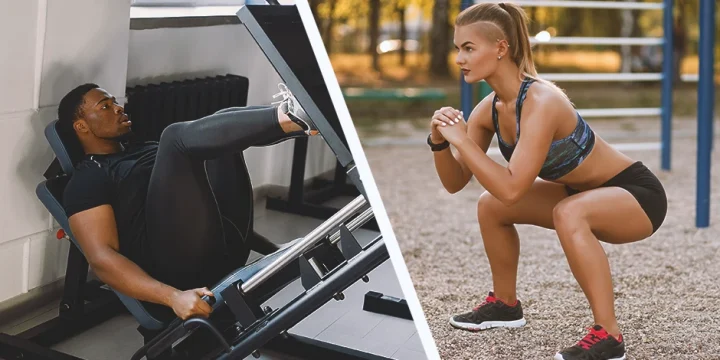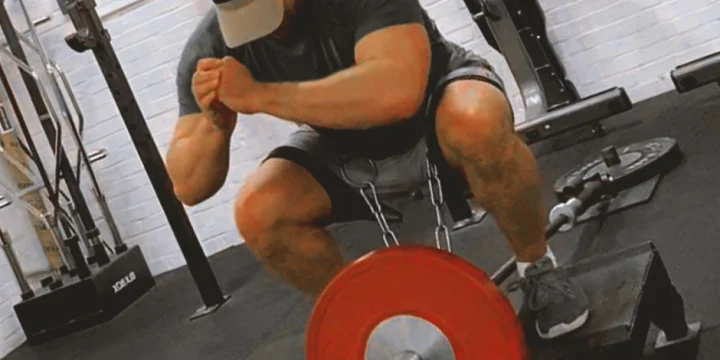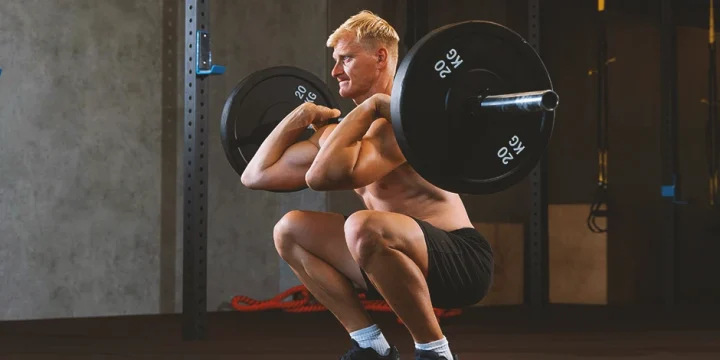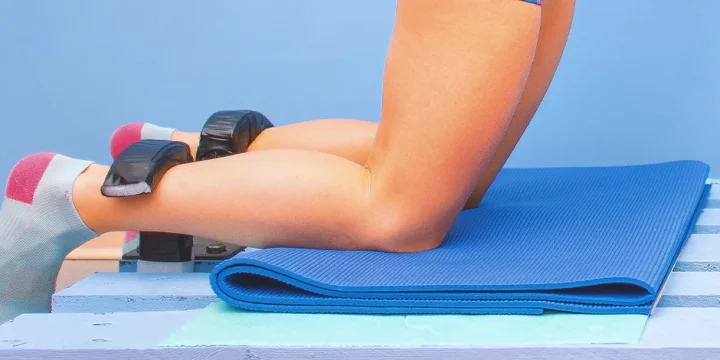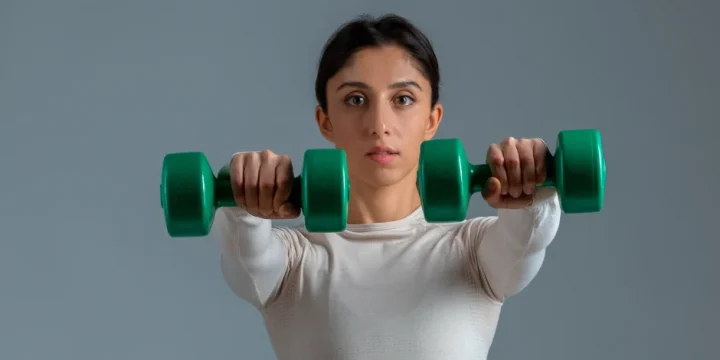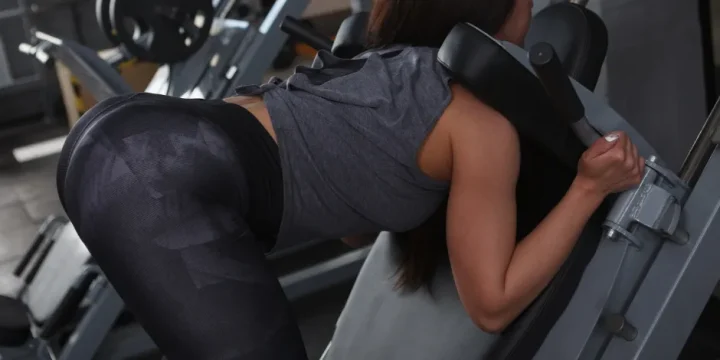Front squats are popular in functional training and bodybuilding programs for their many advantages and variations.
As a personal trainer, I ensure that all my clients become familiar with the front squat because it's surprising how many people get the form wrong.
I'd like to extend this knowledge to all my readers as well.
So, take a deep breath, brace your core, and discover the fundamentals to improve your front squat form.
Quick Summary
- The front squat engages the lower body, specifically the quadriceps, glutes, and hamstrings, while also utilizing the core, upper back, and shoulder muscles for stabilization.
- There are various front squat techniques, including the double kettlebell front squat and sandbag front squat, each requiring specific equipment and form adjustments.
- According to a study on Bartleby Research, front squats are effective for building lean muscle mass, contributing significantly to fitness goals.
- From my experience, front squats are a versatile and essential exercise, offering benefits in strength, stability, and injury prevention, making them a valuable addition to any fitness regimen.
What Is the Front Squat?
The front squat is a compound strength training exercise that primarily targets the muscles of the lower body, specifically the quadriceps, glutes, and hamstrings. It also engages the core, upper back, and shoulder muscles as stabilizers.
According to a study on Bartleby Research, front squats are a great way to build lean muscle mass to help you achieve your fitness goals [1].
“In a healthy breathing pattern, the diaphragm should do most of the work, and the muscles of the ribcage should only assist a bit. When you breathe this way, on your inhale, you should see the abdomen expand in all directions, and your rib cage shouldn’t rise. This creates a cylinder full of air inside the torso.”
- Brian Carroll, Powerlifter
Best Front Squat Versions to Try

One of my favorite things about the front squat is how many variations it has.
Each variation has different requirements, like lifting straps or different hand or leg positions.
1. Double Kettlebell Front Squat
The double kettlebell front squat is a versatile exercise that engages your lower body, core, and upper body simultaneously. It requires you to hold a kettlebell in each hand at shoulder level while performing a full squat.
From my personal experience, this exercise offers the added benefit of enhancing overall strength, stability, and coordination due to its inherent instability.
To make the most of this exercise, it's essential to maintain proper form throughout. If you're new to it, I recommend starting with lighter kettlebells to ensure you can perform the movement correctly while gradually progressing to heavier weights.
Also Read: How to Do Squats With Resistance Bands
2. Sandbag Front Squat
The sandbag front squat is a strength-building exercise that places emphasis on your lower body and core while incorporating a sandbag as resistance.
This exercise is unique because the shifting weight of the sandbag challenges your balance and coordination, ultimately contributing to improved overall strength and stability.
To perform this exercise effectively and safely, remember to maintain an upright torso position, keep your spine in a neutral alignment, and ensure that your knees are aligned over your toes throughout the movement. Proper form is key to reaping the full benefits of the sandbag front squat.
Checkout these Sandbag Workouts:
3. Front Rack Carry
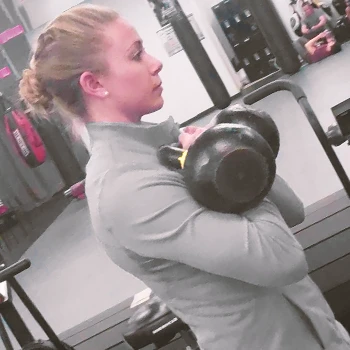
In my fitness journey, the front rack carry has proven to be an invaluable exercise for building core strength and enhancing postural awareness.
To perform the front rack carry, you'll need a pair of kettlebells or dumbbells held in the 'front rack' position, where they rest at shoulder level with elbows bent and facing forward.
The challenge I found doing this exercise for the first time was walking for a specified distance or time while maintaining an upright posture and a tight core throughout the movement.
4. Barbell Front Squat
The barbell front squat is a compound exercise that targets the quads, glutes, hamstrings, core, and upper back.
Unlike a traditional back squat, the barbell is held in front of the body, resting on the front of the shoulders, with elbows pointing forward and the upper arms parallel to the ground.
It requires strength and flexibility, particularly in the hips and shoulders.
5. Zercher Squat
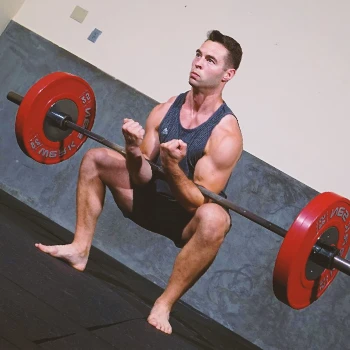
Zercher squat is a variation of the back squat in which the barbell is held in front of the body, supported by the crooks of the elbows.
It is more challenging than the back squat, requiring higher core strength and stability.
This front-loaded exercise requires you to maintain an upright torso throughout, engaging your core and back muscles, which makes it an effective full-body movement.
The Zercher squat encourages a deeper squat thanks to the front-loaded weight.
6. Heel Elevated Squats
Heel-elevated squats are a front squat alternative that involve placing a weight plate or other object under your feet.
This allows you to squat deeper, which translates to an improvement in your range of motion and activates more muscle groups.
This squat variation is particularly beneficial for individuals with limited ankle mobility.
7. Dumbbell Goblet Squat
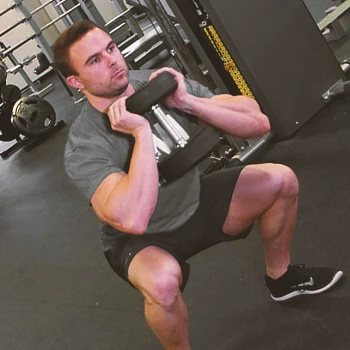
I've found that the dumbbell front squat is good for promoting an excellent squat form, thanks to the weight placement in the front. It reduces strain on the lower back.
It also aids in achieving a deeper squat, increasing glute muscle activation.
8. Front Rack Kettlebell Squat
The front rack kettlebell squat has been a valuable addition to many of my clients’ fitness routines. This exercise involves holding a kettlebell in front of the shoulders and is designed to target the quads, glutes, and hamstrings while promoting lower body strength and muscle development.
What makes the front rack kettlebell squat particularly effective is its ability to enhance core stability, balance, and overall strength.
Maintaining proper form is crucial to reap the full benefits. This includes keeping your back straight and ensuring your knees are correctly aligned.
9. Safety Squat Bar Squat
This exercise uses a specialized bar that distributes weight evenly across the shoulders and back, making it a more comfortable and accessible exercise for people with shoulder or back pain.
The bar has a padded section that rests on your shoulders and handles, allowing you to hold on and maintain control during the exercise.
Related Articles:
Types of Squat Grip

Based on my experience, there are three squat grips that you should practice: clean, crossed, and strap.
1. Clean Grip
The front squat with a clean grip is a variation that uses the hand placement typically seen in the Olympic lift.
Here’s what you must consider:
- The barbell is held in front of the body, resting across the front of the shoulders.
- The hands are positioned just outside of the shoulders, palms facing up, with the fingers loosely under the bar and the elbows pointing forward and kept high.
This grip requires wrist and shoulder flexibility but allows better barbell control and encourages a more upright torso during the squat.
2. Crossed-arm
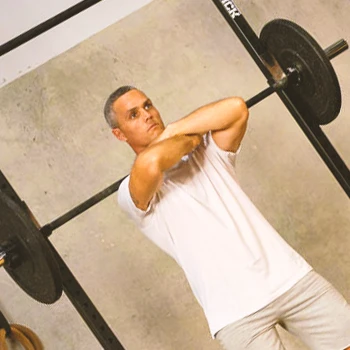
The cross-arm grip lets your shoulders support the barbell on the front during a squat.
This grip is comfortable for those with narrow shoulder or wrist mobility, as it doesn't require as much flexibility as the clean grip.
3. Strap Grip
This front squat grip uses straps to hold the barbell. They're attached to the barbell to give you a secure and comfortable hold.
It’s beneficial for individuals with limited wrist or shoulder mobility, as it reduces the strain on these areas.
You can maintain a more upright posture and keep the elbows high, promoting proper squat form.
Complementary Front Squat Equipment

Having experimented with various equipment over the years, I highly recommend the following front squat equipment for your training:
- Knee sleeves: Knee sleeves help to reduce the amount of stress during a front squat. They are also warm and prevent injuries.
- Weightlifting shoes: Weightlifting shoes have raised heels that help to improve your squat depth and technique.
- Waist belt: A waist belt provides support and stability during a front squat. It also protects your lower back from injuries.
- Squat rack: A squat rack allows you to load and unload the barbell safely and securely.
Related Article: Belt Squat Alternatives
Which Muscle Groups Does Front Squat Train?

The front squat works multiple muscle groups, including the quads, hamstrings, glutes, core, shoulders, and upper back.
Here's the significance of each of these muscles:
- Quads: The quadriceps, or quads, are a group of four muscles at the front of the thigh responsible for knee extension and hip flexion [2].
- Hamstrings: The hamstrings consist of three muscles at the back of the thigh, which help with knee flexion and hip extension.
- Glutes: The gluteal muscles comprise three muscles in the buttocks area. They are key in hip extension, rotation, and abduction.
- Core: The core refers to the muscles around your trunk and pelvis, including the abs, obliques, and lower back muscles. They are essential for stability, balance, and power generation in most physical activities.
- Shoulders: The shoulders have several muscles (deltoids and rotator cuff muscles included). They allow you a wide range of motion and stability in the shoulder joint.
- Upper back: The upper back includes muscles like the latissimus dorsi, rhomboids, and trapezius. They contribute to movement and shoulder blade stability.
Why You Should Train Front Squats
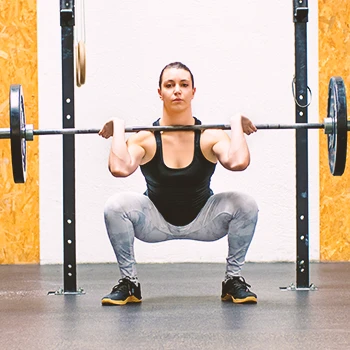
There are many reasons why the front squat is my favorite exercise [3]. Here are just some of the benefits of this amazing exercise:
- Builds strength and muscle mass
- Improves weightlifting technique
- Increases mobility
- Improves posture and spinal alignment
- Reduces the risk of injury and wrist pain
Injury Prevention and Rehabilitation with Front Squats
Over the years, I’ve learned that front squats are not only a powerful exercise for building strength and muscle mass but also play a significant role in injury prevention and rehabilitation.
Their unique mechanics can be particularly beneficial for athletes and individuals recovering from certain types of injuries.
1. Understanding the Mechanics
The front squat places a greater emphasis on the anterior (front) part of the body, including the quadriceps and core muscles. This upright position reduces the strain on the lower back compared to back squats, making it a safer alternative for individuals with lower back issues.
2. Core Stability and Posture
Front squats require a strong engagement of the core muscles to maintain an upright torso. This engagement strengthens the core, which is crucial for injury prevention, as a strong core supports the spine and can reduce the likelihood of back injuries.
3. Knee Stability and Rehabilitation
Front squats can be beneficial for knee rehabilitation. The exercise encourages proper knee tracking, reducing the risk of knee valgus (knees caving in), a common issue that can lead to injuries. The quadriceps are heavily engaged in this exercise, which is essential for knee joint stability.
FAQs
Are Front Squats Difficult?
No, front squats aren't difficult. They're only challenging if you don’t have the fundamentals like starting position or proper posture. They require a lot of mobility and strength as the weight is held in front of the body, which puts a lot of stress on the shoulders and upper back.
Does Conventional Front Squat Use More Muscles than Other Front Squat Alternatives?
Yes, the conventional front squat uses more muscles than other front squat alternatives. This is because it's performed with the barbell across the deltoid, which requires more shoulders and upper back mobility. It also requires more core strength to stabilize the weight in front of the body.
References:
- https://www.bartleby.com/essay/Are-Deep-Squats-A-Safe-And-Viable-FK3Z9E9CP9L5
- https://www.researchgate.net/publication/357897278
- https://www.researchgate.net/publication/333141018
About The Author
You May Also Like
